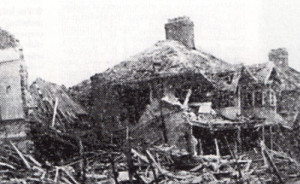
Although missiles are now accepted weapons of war, well over 50 years have elapsed since their precursors, Hitler’s flying bombs, were used, first against Southern England and later the North.
This is the story of one family’s first experience of the new weapon.
The Finch family – mother, daughter and teenage son -had been out of their beds since late the previous night, and had spent an uncomfortable few hours sitting on the bedless bunk frames in their Anderson air-raid shelter at the bottom of the garden, to which they had retreated in something like surprise after the warning siren had woken them. Surprise because there had been no ‘alerts’ for a very long time and the war was generally considered to be almost over.
It simply couldn’t last much longer now: the steady tones of General Eisenhower had announced the invasion of Europe only ten days previously on June 6, and newspapers were assuring readers every day that the liberation of Nazi-held territory was certain for 1944.
Their time in the shelter had been more difficult to endure because absolutely nothing had happened, so they’d retreated back into the house and stood about disconsolately, hands thrust in the pockets of their dressing gowns which had been thrown over night clothes, and waited.
Scarcely audible in the distance a clock struck four, then silence descended again, perhaps not so complete as it had been, though, for a long way off something was buzzing – a motorcycle, perhaps? Yes, it was closer now, and had an odd note about it, seeming to come from the sky rather than the road. The family tensed as the noise reached a crescendo.
“Down!” shouted the daughter firmly, and the three dropped on to the carpet. Moments afterwards there was an explosion like a roll of thunder, and the boy was in time to see the french doors flung open – not violently, but almost slowly, as if by a leisurely, giant hand.

Dazed for only a moment, the Finches were quickly on their feet, the son announcing: “I’m going to have a look” before making his way to the front door and then along the street in front of his mother and sister. It wasn’t long before they came upon a scene of chaos. Scattered about the pavement was a great quantity of broken and splintered wood, and four semi-detached houses appeared to have had their fronts punched in by a giant fist, those in the centre having been reduced to nothing more than the rear walls. Roofs in the vicinity which had remained in position had been flung into an angry sea of tiles, and across the road a great waste of masonry and wreckage marked the site of the detached house that had suffered the main force of the explosion. Above the sounds of the rescuers’ endeavours rose another strange engine beat and one of the men warned: “Watch out – he’s still about up there!”
A quarter of a mile away the family of young Finch’s girlfriend was much better informed. Father, mother, their two sons and daughter had climbed on to the top of their garden air-raid shelter to gain a better view and were listening to their eldest, an RAF bomber pilot on leave. This, he told them, was a new and different weapon, a small aeroplane which, without crew of any kind, flew to its target with explosives and destroyed itself there – a flying bomb.
Although my book Flying Bomb (Robert Hale) is now out of print, copies are still obtainable by order on loan from public libraries.
Peter G. Cooksley








